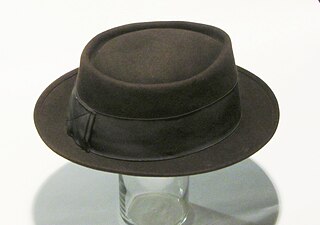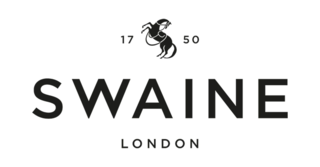
Hat-making or millinery is the design, manufacture and sale of hats and other headwear. A person engaged in this trade is called a milliner or hatter.

The bowler hat, also known as a Coke hat, billycock, bob hat, bombín (Spanish) or derby, is a hard felt hat with a rounded crown, originally created by the London hat-makers Thomas and William Bowler in 1849 and commissioned by Lock & Co. Hatters of St James's Street, London. It has traditionally been worn with semi-formal and informal attire.

A top hat is a tall, flat-crowned hat traditionally associated with formal wear in Western dress codes, meaning white tie, morning dress, or frock coat. Traditionally made of black silk or sometimes grey, the top hat emerged in Western fashion by the end of the 18th century. Although it declined by the time of the counterculture of the 1960s, it remains a formal fashion accessory. A collapsible variant of a top hat, developed in the 19th century, is known as an opera hat.

A hat is a head covering which is worn for various reasons, including protection against weather conditions, ceremonial reasons such as university graduation, religious reasons, safety, or as a fashion accessory. Hats which incorporate mechanical features, such as visors, spikes, flaps, braces or beer holders shade into the broader category of headgear.

A slouch hat is a wide-brimmed felt or cloth hat most commonly worn as part of a military uniform, often, although not always, with a chinstrap. It has been worn by military personnel from many different nations including Australia, Ireland, the United Kingdom, Canada, Nepal, India, New Zealand, Southern Rhodesia, France, the United States, the Confederate States, Germany and many others. Australia and New Zealand have had various models of slouch hat as standard issue headwear since the late Victorian period.

A fedora is a hat with a soft brim and indented crown. It is typically creased lengthwise down the crown and "pinched" near the front on both sides. Fedoras can also be creased with teardrop crowns, diamond crowns, center dents, and others, and the positioning of pinches can vary. The typical crown height is 4.5 inches (11 cm). The term fedora was in use as early as 1891. Its popularity soared, and eventually it eclipsed the similar-looking homburg.

A trilby is a narrow-brimmed type of hat. The trilby was once viewed as the rich man's favored hat; it is sometimes called the "brown trilby" in Britain and was frequently seen at the horse races.

Stetson is an American brand of hat manufactured by the John B. Stetson Company. "Stetson" is also used as a generic trademark to refer to any campaign hat, particularly in Scouting.

A pork pie hat is one of several different styles of hat that have been worn since the mid-19th century. The pork pie hat gained further popularity in the 20th century, being worn by famous actors and musicians. This style of hat features a flat crown that resembles a traditional pork pie, thus earning its name.

Akubra is an Australian hat manufacturer owned by Tattarang since November 2023. The company is associated with bush hats made of rabbit fur felt with wide brims that are worn in rural Australia. The term "Akubra" is sometimes used to refer to any hat of this kind, however the company manufactures a wide range of hat styles including fedora, homburg, bowler, pork pie, and trilby.

Swaine London, known previously as Swaine Adeney Brigg, is a luxury goods shop that has traded in London's St James's since 1798. The shop sells leather goods, Brigg umbrellas and hats from Herbert Johnson.
Prudence Millinery designs and makes couture hats for major designers all over the world.
Henry the Hatter is a retail store in Detroit, Michigan. It was founded by Henry Komrofsky in 1893.

The Barbara Feinman Millinery is a custom hattery in New York City's East Village. Feinman hats are made by two other milliners using a 100-year-old sewing machine and various materials.
Coloroll is a United Kingdom wallpaper brand owned by CWV Ltd.
Founded in the 1780s, Köhler & Son were independent makers of brasswind instruments in London until they were bought by Swaine & Adeney in 1907.
G. & J. Zair were independent whip-makers founded in the 1830s in Birmingham until they were bought by Swaine & Adeney in 1927.
Thomas Brigg & Sons, said to have been founded in 1836, were makers of umbrellas and canes in London. They merged with the London firm of Swaine & Adeney to form Swaine, Adeney, Brigg & Sons Ltd in 1943.
Papworth Industries was the name given to the manufacturing arm of Papworth Village Settlement, a Cambridgeshire colony for sufferers of tuberculosis founded in 1916. The luggage and travel-goods division was bought by the London firm of Swaine Adeney Brigg in 1997.












